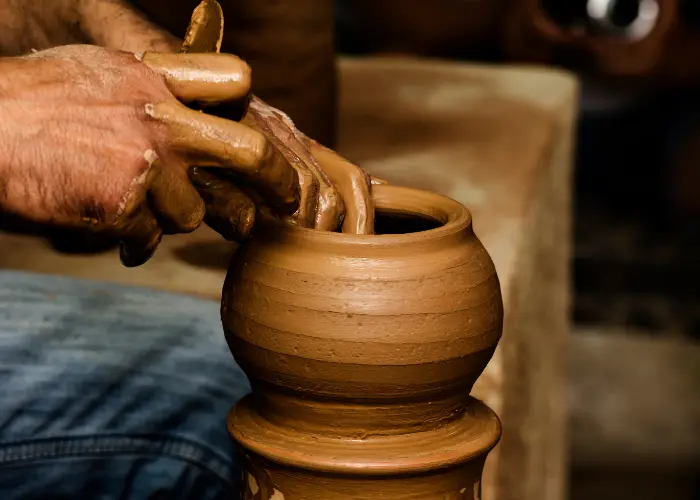Clay, one of the most ancient and versatile materials known to humanity, has played a pivotal role in the development of civilizations across the globe. Its significance stretches back thousands of years, serving as a medium for art, functionality, and innovation. From the earliest mud structures to sophisticated pottery designs, clay has continually shaped not only physical landscapes but also cultural identities.
The story of clay is not simply one of craftsmanship; it is a story of human ingenuity, survival, and expression. It is remarkable how a simple, malleable substance can evolve into intricate forms that span the realms of art, utility, and even spiritual significance. The earliest known use of clay dates back to the Paleolithic period, around 25,000 years ago, where evidence of rudimentary clay figurines and objects has been discovered. These primitive creations were often made using hand-building techniques, where the artist would mold and shape the clay into simple forms. These early clay pieces were primarily for practical purposes, such as storing food or water, but over time, they evolved into more intricate works of art. The ancient civilizations of Mesopotamia, Egypt, and the Indus Valley were among the first to truly harness the full potential of clay, using it not only for daily life but also for creating advanced pottery, ceremonial objects, and even written language. The ancient Sumerians, for instance, invented the cuneiform script, one of the first systems of writing, on clay tablets, leaving a permanent record of human history. In Egypt, clay was used for the construction of monumental structures like the iconic pyramids, and in ancient Greece, potters elevated the craft to an art form, creating beautiful, detailed vessels that told stories through intricate designs.
The Romans, too, contributed to the evolution of clay, developing advanced methods of glazing and firing pottery, a tradition that would lay the groundwork for modern ceramics. As civilizations spread across continents, so too did the art of clay crafting, with unique techniques and styles developing in regions as diverse as China, Africa, and the Americas. The Chinese, for example, refined porcelain, creating fine, translucent clay that became highly sought after by royalty and collectors. African pottery, on the other hand, carried deep cultural significance, often being used in rituals, ceremonies, and as symbolic artifacts. Across the Americas, indigenous cultures also created remarkable pottery, often incorporating intricate designs and symbols that connected the physical world with the spiritual realm. The Middle Ages marked a period of innovation and experimentation in clay, particularly in Europe. Pottery was still used primarily for functional purposes, such as creating storage jars, cooking vessels, and tiles for roofing. However, as trade routes expanded and cultures collided, there was an increased exchange of ideas and techniques that led to the development of new glazes, firing methods, and decorative styles. The introduction of the potter’s wheel in ancient Mesopotamia revolutionized pottery making, allowing artisans to create more uniform and precise vessels. This tool spread across cultures, becoming a standard in pottery workshops around the world. By the time the Renaissance arrived, pottery was no longer just a functional craft—it was an art form in its own right. Potters and ceramicists began experimenting with colors, shapes, and textures in ways that had never been done before. The influence of Renaissance artists, like those who designed ornate, decorative pottery for wealthy patrons, transformed clay into a medium for high art. The Industrial Revolution brought with it mass production techniques, and while this shift reduced the need for handcrafted pottery, it also led to the creation of new innovations in the field. Mass-produced clay items became more accessible to the general public, but the spirit of craftsmanship remained strong in smaller, artisan pottery studios.
The 20th century saw a resurgence in interest in handmade pottery and ceramics, as artists returned to traditional methods and focused on personal expression. Movements like the Arts and Crafts movement in England and the Studio Pottery movement in the United States championed the handmade aesthetic, emphasizing the value of artisanal skills over mass production. Today, the world of clay products is as diverse as ever, ranging from utilitarian objects to fine art. Artists and potters continue to push the boundaries of what clay can achieve, experimenting with new techniques, glazes, and firing methods. The role of clay has expanded, incorporating technology and innovation into age-old techniques. For example, 3D printing technology is now being used to create clay objects with precision, while artists are experimenting with alternative firing methods like raku and smoke firing to achieve unique, unpredictable results. The allure of clay lies in its inherent versatility. Unlike many other materials, clay can be molded, shaped, and transformed into an endless variety of forms, making it the ideal medium for both functional objects and artistic expression.
It is a material that invites experimentation, and even in its most basic, unshaped form, it holds the potential for transformation. For centuries, clay has been used to craft everyday objects—mugs, bowls, plates, and vases—forms that continue to be loved and appreciated for their tactile, earthy qualities. Yet, the beauty of clay extends beyond its practical uses. It is a medium that holds deep personal significance for those who work with it, offering a chance to connect with ancient traditions, explore one’s creativity, and create something that can be cherished for generations. There is something deeply meditative and therapeutic about working with clay. Whether it’s the sensation of molding a lump of earth with your hands, or the focused attention required to perfect a glaze, clay crafting has long been known for its calming and centering effects. Many potters describe the act of working with clay as a form of self-expression, a way to engage with their inner world and create something unique.
As we look forward, it’s clear that the role of clay products will continue to evolve, adapting to changing tastes, technologies, and environmental needs. While mass production and industrial techniques have altered the landscape of pottery and ceramics, there remains an undeniable reverence for handmade clay products. The tradition of clay crafting continues to thrive, both as an art form and as a means of creating functional, sustainable products. The timeless appeal of clay will no doubt continue to inspire artisans, collectors, and enthusiasts alike, preserving its legacy as one of the most enduring and essential materials in human history.



